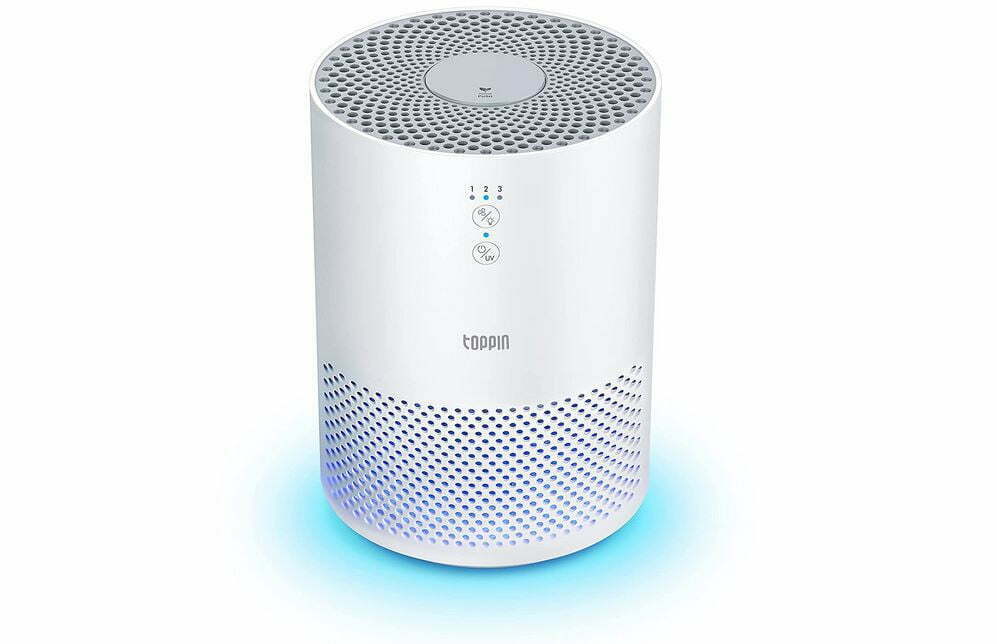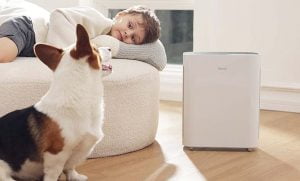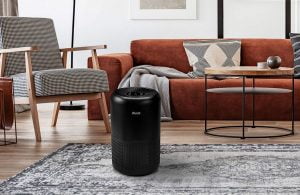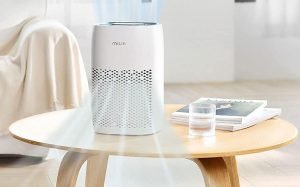UV Air Purifiers Pros and Cons
UV air purifiers or ultraviolet air purifiers are air purifiers which use ultraviolet light to help clean the air.
Ultraviolet light is electromagnetic radiation with a wavelength shorter than that of visible light and is in the range of 10 to 400 nm. Therefore, although it’s called ‘light’, uv light is not actually visible since its wavelength is outside the range of that of visible light.
In nature, sunlight emits ultraviolet light, and so do electric arcs and specialized lights such as black lights. Ultraviolet air purifiers use specialized light bulbs or lamps to emit ultraviolet light.
So what does the ultraviolet light do and why is it used in an air purifier?
UV Air Purification System
UV air purifiers work by emitting UV radiation which arrest the replication of DNA of a microorganism.
As mentioned above, ultraviolet light comprises of electromagnetic radiation with broad wavelength range.
The short wave part of this range (<280 nm), also known as UV-C, has germicidal capability and therefore is often used to sterilize medical tools and labs, as well as for disinfecting drinking water. It basically works by creating radiation which results in the change of the structure of genetic material of bacteria, viruses and some protists. This change renders them unable to replicate and therefore harmless. Sometimes, a catalyst such as titanium oxide is also used to speed up the process.
Why Choose UV Air Purifiers ?
Companies which make home UV air purifiers claim that the use of ultraviolet light will make the air cleaner free from germs because it ensures the air purifier to catch every single germs which comes into the unit.
In this respect, it is important to note that as oppose to a room sanitizer or sterilizer where ultraviolet light is the major sterilizer, ultraviolet lamps in an air purifier are actually an addition to the existing filtering mechanism. For instance, ultraviolet lamp is sometimes added to a HEPA or ionic air purifier.
Thus, the bulk of filtration is done through mechanical (in case of HEPA filter) or electronic (in case of ionic air purifier) means, and the UV light only deals with viruses which are too small they may escape the system.
The question is: can the UV light actually do its job when put in an air purifier ? The efficacy of UV light depends on the dosage and exposure time. We must remember that an air purifier uses fans to move air through and out the air purifier. Thus, to make the UV inside the air purifier effective, an air purifier manufacturer must ensure they get the dosage and exposure time correct; all while considering the air movement within the unit.
Another purpose of using an ultraviolet light in the air purifier is to actually sterilize the HEPA filter itself. If you ever seen a prefilter or a HEPA filter in an air purifier unit, you must have seen how they are loaded with dust and mold. There is no doubt that those dirty filters also contain a variety of microorganism. Some air purifiers deliberately include ultraviolet lamp to sterilize the filter, so the filter does not become a source of harmful microorganism.
However, it is known that UV-C can make HEPA or other filters brittle. Any lab worker will notice the brittleness of the lab bench mat after it’s exposed to UV light regularly.
To circumvent this problem, some air purifier manufacturers incorporate germicidal screen such as silver screen to stop the microorganism replicating and living in the filter. Airgle and Winix Plasmawave are two of the air purifiers which use this technology to ensure there is no build up of germs within the air purifier unit.
Does Home UV Air Purifier Work ?
While theoretically the UV light will do its job properly, provided the manufacturer gets the dosage and exposure time correct, the effectiveness of UV air purifiers is still debatable.
For instance, will it really provide better air compared to the one provided by good quality HEPA air purifier with no UV capability ? After all, a high quality HEPA filter combined with carbon in a premium air purifier will automatically arrest microorganism which goes into the unit, right ?
Yes, if one has a good quality air purifier with a good HEPA and carbon filter, as well as tight housing (to prevent dirty air bypassing the filter), then there should be none or very little amount of particulates left when the clean air is blown from the air purifier. Hence a UV light is not needed.
This is certainly the case with a good quality HEPA air purifier, IQAir. Back in 2003, during the height of SARS scare in Asia, Hongkong Department of Health chose good quality HEPA air purifiers with no UV capability (IQAir) to help fight SARS, and the government officials have been happy with this air purifier’s performance.
So obviously, a very good air purifier does not need UV to trap microorganism since it has already a good filter to trap most, if not all, of them. This is supported by the assertion from Center of Disease Control which states that incorporating UV into a HEPA air purification system does not improve it.
Therefore, if you already have a good air purifier or are aiming to buy one with that kind of quality , you might be better off investing in a room sterilizer or sanitizer instead. That way, microorganism which does not go to your air purifier can be dealt with by the room sterilizer.
Having said that, we observe there are many lower quality air purifiers which have UV lamps. In the situation when the air purifier is not good enough to trap most of the particulates, it makes sense to have a UV light in it.
But then, of course the effectiveness of the UV light in that situation depends a lot on the manufacturer, for instance whether they have the right dosage or the right exposure time to ensure the UV light can do its job properly. If you decided to buy the lower quality air purifiers with an ultraviolet lamp, make sure you read the section below because there are some safety issues which you need to be aware of.
Potential Drawback of Using Home UV Air Purifiers
Safety: Ozone Production.
One of the major drawbacks of using a home UV air purifier is that it produces ozone as a byproduct. Fortunately, ozone-free UV air purifiers are available and these machines are produced by NQ Clarifier and Allerair. If you are not buying either NQ Clarifier or Alleraire ultraviolet air purifiers, then make sure that the machine you want to buy has addressed the ozone problem. This is especially important if you have individuals which is vulnerable to ozone exposure, such as those with lung diseases or somebody which has problems with their immune system.
Safety: Mercury.
UVC radiation, especially the specific wavelength used for germ killing (254 nm), is emitted from mercury gas contained in a light bulb or lamp. Unfortunately, some mercury lamps are not sufficiently tough to ensure that they are not easily broken. Hence, here is one possible hazard associated with having a UVC lamp. We also suggest you to handle the light bulb carefully during replacement, since it is important not to break it. Also, since UV-C light is not human-friendly, make sure you turn the power off when you replace the bulb to avoid exposure to the UV-C.
More Expense
Adding the UV light feature into an air purifier costs money, both upfront and during one-year bulb replacement. Allerair, a premium air purifier manufacturer, for instance, charges $200 for upgrade to include a UV air purification system into their existing HEPA air purifier unit. The cost of replacement also varies depending on the manufacturer, but the range is between $30- over $100 yearly.
To Sum Up …
All in all, as much as we want to believe that an air purifier with UV light will significantly desinfect our home, the truth is, its efficacy might not be that different from a good HEPA air purifier with no ultraviolet light at all. If you want to have the benefit of the UV light to disinfect your home, then it’s better to invest in both air sanitizer or sterilizer and air purifier. Air sanitizers work by forcing the air of your home to go through it and while there the air gets bombarded by the UV light. So in essence, the air in your room or home will be exposed the UV light. We believe, it is more effective to do so.
And finally, for those who want an ultraviolet air purifier to ensure that the filters does not become a sink of microorganism, then we encourage you to try air purifiers which incorporate germicidal screen to kill trapped microorganism in the filter, such as Winix Plasmawave and Airgle.




